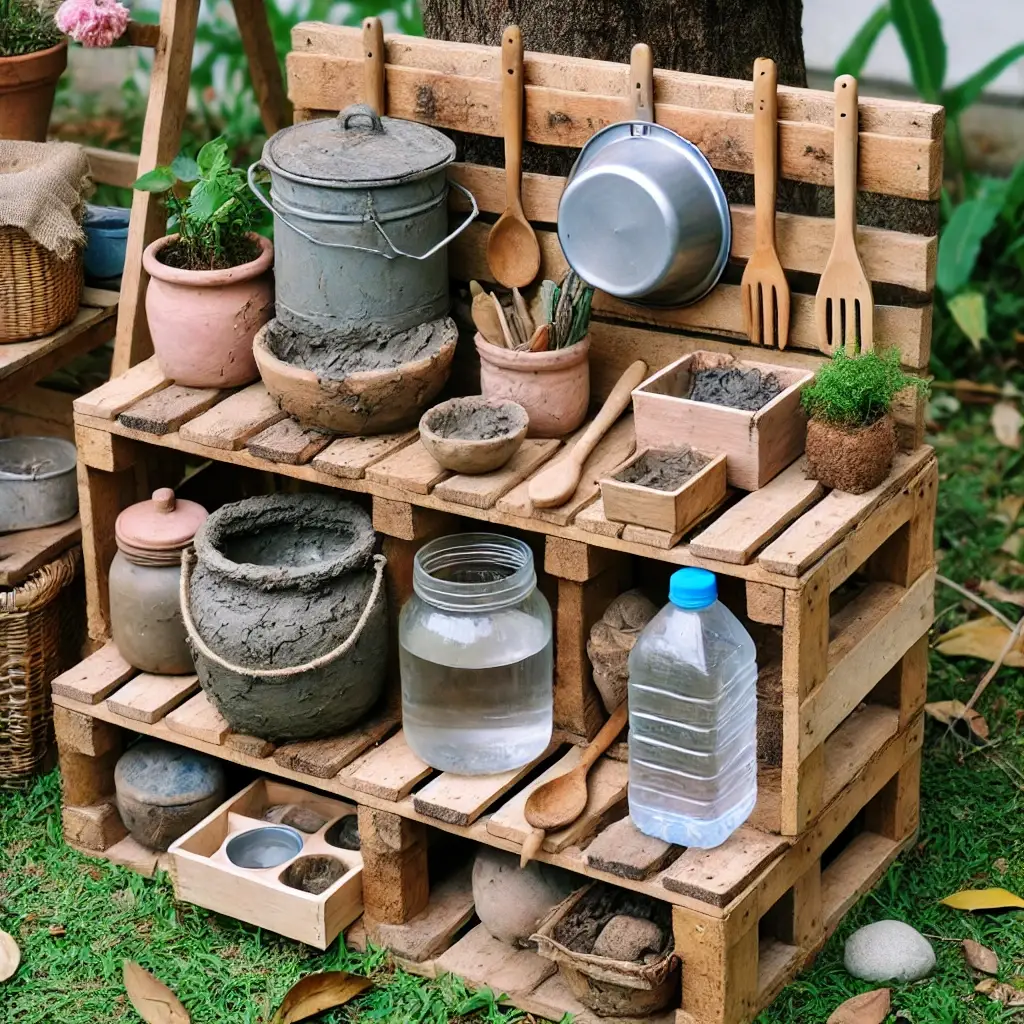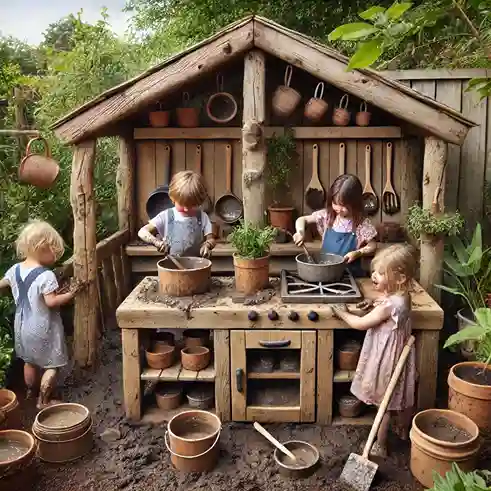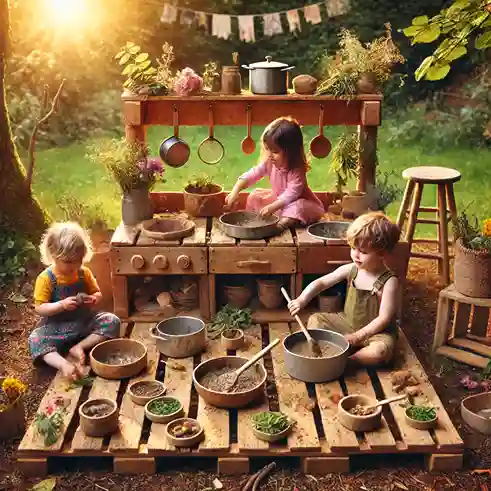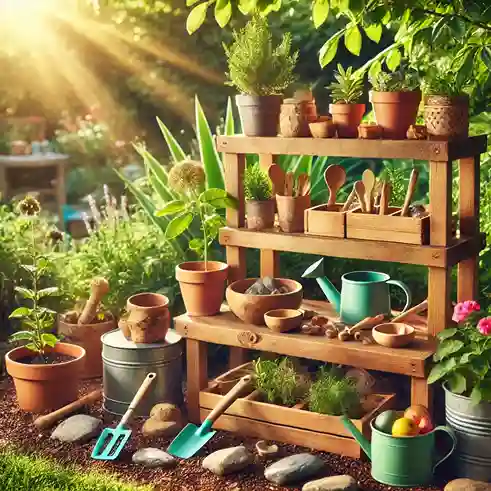Introduction to Mud Kitchen Designs
Outdoor play structures aimed at enhancing children’s creativity as well as boosting their hands-on learning techniques best describe mud kitchens. At their core, mud kitchens are wooden or plastic composites which enable children’s imagination with basic constituents like dirt, water, and leaves. Most mud kitchens mimic ‘miniature’ kitchens and consist of instruments from where children can add dirt or mud, combine, and create culinary dishes. The growing trend of mud kitchens among the parents and teachers is as a result of the need of enhancing outdoor play as well.
The whole idea revolving around mud kitchen is to foster free play. When children interact with natural elements, they investigate infinite opportunities the surroundings have to offer to them. Using dirt and water enables children to engage in block play which enhances their cognitive and emotional development. This active form of play also gives room for creativity where children can solve problems and work together in order to accomplish a goal while being in an outdoors environment.
Moreover, even the existing studies have praised outdoor play’s advantages over indoor play. Children that in nature have improved attention span, physical fitness, and mood. The play with mud and other natural elements also strengthens the sense of responsibility towards the environment education through its creative use. With the details of this blog, I have collected ten example designs of mud kitchens to demonstrate how they also give rise to creativity and make your backyard an interesting classroom. Combining play and learning, such constructions of mud kitchens provide an effective and enjoyable way of growing up for young children as well as a more natural way of learning.
Health and Development Benefits Accrued from Outdoor Play
Outdoor play is important for the general growth of a child, along with the encouragement of many health and brain functions that are critical in the early years. Apart from other activities, using mud kitchens is also important as it cuts across the physical fitness line. In such experiential learning situations, children are involved in gross motor skill activities that include running, jumping, digging, and climbing. Movement exercises improve strength, coordination, and physical fitness. Such research reveals that active child who plays outside, is less likely to be overweight or obese while active play is necessary to prevent the illness.
Mud kitchens are not just limited to their physical characteristics, as they provide a distinct chance for cognitive growth. While working with real materials such as dirt and water, children use their hands and brains together looking for solutions and alternatives. They test as well as notice the set of interdependencies revolving around the density of a particular material. This form of practice also assists the children to learn some of the basic principles of science as well as exercise their imagination and creativity. Also practice of pretend play in which children create their own restaurants enables kids to strengthen their cognitive skills as they include planning and organization.
From a social perspective outdoor play including activities involving mud kitchens gives children the chance to build social and communication skills. Kids understand how to divide and allocate resources, work together on objectives, and handle conflicts as they arise, enhancing their social interaction and emotional regulation. By taking turns and participating in imaginative plays, children learn to sympathize with their peers. Furthermore, being outside is good for mental health so spending more time outside is beneficial as well. The connection to nature allows children to feel free which evokes a comforting and loving feeling.
To summarize, the multiple benefits which children derive engaging in unstructured outdoor activity, placing particular emphasis on mud kitchens, go a long way in the boosting the physical, cognitive, social and even emotional development of the children and which underlines the importance of outdoor play in the early years of development.
Design Inspiration: Rustic and Natural Materials

As for the waterplay areas, mud kitchens serve as a different mean of creative outdoor play for the children at any age while relating them to nature. The use of rustic and natural materials in mud kitchen constitutes one of the most interesting parts of the design as such materials as well compliment the aesthetics and foster sustainability. Materials such as wood, stones and clay, seamlessly integrate into the outdoor setting and contribute to a functional environment that encourages children’s exploration and creativity.
Mud kitchen designs are largely constructed out of wood for these reasons and many more. Authentic wood grain, texture, and warmth provide as organic elements of the design. From reclaimed timber counter tops of the sink sections to the untreated logs which define the structure itself, the wood certainly adds to the rustic charm and supports resiliency. The natural finishes applied on the mud kitchen designs timber also guarantees the children the mud kitchen designs are safe to use whilst keeping the elements out and ensuring longevity.
The use of stone in mud kitchen designs adds another level of beauty and ruggedness for stone possesses strength and permanence and can be used to integrate sinks, serve as bases or path, and for countertops. It can create an earthy palette in combination with the tenderness of the greens surrounding the kitchen area because of its texture and variety of colors. In addition, stone is resistant to weather changes. Hence, it can be used outdoors too.
Another aspect that is sometimes underrated, is the use of clay in mud kitchen designs. The use of clay including pottery and sculptors makes the children encourage interacting the environment around them in a tactile and imaginative way. They provide sensory experiences which enhance their creativity and teach them natural components of the environment around them.
The use of natural rustic materials into mud kitchen designs enables the creator to create rooms that are beautiful and environmentally conservative. Such materials serve the purpose of establishing nature contact which is critical for children’s creativity during outdoor play.
Functional Characteristics: Partition, Supply, and Place of Work

The mud kitchen designs must include a balance of features that both serve its practicality and encourage children’s creativity while playing outside. These include, having places to put things, work areas, and the availability of water among other things. The factors mentioned above in one way or another assist in achieving cosplay friendly and functional work spheres.
The first principle of mud kitchen designs is storage. Having set places for cooking or cleaning items such as spades and buckets enables children to learn how to tidy up and be accountable. Storage can be in the form of shelves, pegboards, or bins among others. The use of weather-friendly materials like wood or metal for the extension will also ensure that the storage is effective and functional over the years to come. Setting compartments at the right height for children facilitates easy access for supplies enabling them to be independent and creative in their use.
Place of Work should provide for enough space that allows for different whipping de mud activities. For example, blocks of dinners can act as the base where combining of ingredients takes place. A consideration should also be how spoons and other items can be put around the work areas’ artefacts such as the workbench to encourage orderliness. Finally, the ability of children’s skills and interests to change should prepare the design of the surfaces for example the tables to be foldable and the surfaces to be several levels.
Access to water is yet another key aspect of a working mud kitchen designs. A water source such as a hose or a tap greatly allows for enhancement of play as well as allows for testing various textures and consistencies of mud. A small basin or water trough can also allow for easy rinsing and form an integral part of the play. Easy to operate devices and properly located plumbing will significantly help in promoting a simplified set up that will aid children in doing water play with less supervision.
Creative Additions: Outdoor Lighting and Decorations
The outdoor lighting and decorations are critical elements when presenting a mud kitchen designs, to improve its appeal and utility value. When such items as lanterns and fairy lights are utilized, the outdoor space can be converted into a playful place with little effort. Gentle outdoor lighting provides visibility within the kitchen at dusk and further provides comfort that encourages the child to undertake many more cooking activities even after night has fallen. These fairy lights detach from the kitchen area and are wrapped on trees within the area to give a beautiful feel of the outdoor experience.
Using colorful decorations is also a fantastic way to create an individual impression on a mud kitchen designs and make it more accessible to children. Decorative elements such as bright pots, odd shapes of signs, and funny ornaments, can beautify the area. Apart from fun, these interesting aspects are able to reactivate children’s imagination as they motivate children to use their creativity while playing. Additionally, combining different surfaces, patterns and hues can enliven the children’s environment and encourage them to be inquisitive and test new ideas.
Moreover, it is possible to use edible plants and combine them with flowers or shrubs as a way to beautify the mud kitchen designs. Similarly, having pots of edible weeds, beautiful flowers or small bushes can enhance the charm of a mud kitchen designs. This not only enriches the aesthetics of the environment but also gives children a chance to interact with nature, take care of plants, and understanding the ecosystem. The green foliage also helps children to manipulate their play activities and fuels their curiosity to investigate nature.
Everything from outdoor lighting and colored decorations to artificial elements can be beneficial as they create an environment that inspires children and beautifies the outdoor play for kids. When decorating a mud kitchen designs, moms and dads and other caregivers can arouse a sense of creativity and help children make the most out of their imaginative play outdoors.
How to Build Your Own Mud Kitchen: A Beginner’s Guide

Constructing a DIY mud kitchen designs can be an exciting venture that helps kids to be creative in the outside. It starts with the choice of construction where it can be a simple workbench or a series of cooking units. Here are step by step instructions for different competencies – this will make it easier for everyone.
A good mud kitchen designs can also be made from using a wooden pallet or plank which is strong enough to serve as a tabletop. Look for pallets and tabletops an lumberyard or recycling center today. Once you have the top surface, use some 2×4 lumber to construct a frame beneath it for a comfortable cooking height. Now fasten this frame with wood screws and check it for stability. Such a mud kitchen designs can also incorporate a simple sink whereby a plastic tub is fitted on the surface for easy washing during play.
For kids who have experience with mud kitchen designs, constructing a tiered version can be attempted. This design can include wooden slabs used as shelves to place bowls and other utensils. Focus on the base structure at first and make sure to add corner brackets for more support. After that, build the frame and place wooden slabs for shelves at strategic locations. For added usefulness get hooks that can be placed on the wall for hanging utensils and bring in one more wooden crate for storage. To make the kitchen more attractive paint it with a child-safe outer paint so that the kids can indulge in artwork while playing.
At last! For cloning aficionados, making a mud kitchen designs with a rustic touch turns out to be a highly satisfying quest. Salvaged wood, stones, and other natural materials can be used to make a very visual pleasing kitchen that is in harmony with nature. First, create a frame using wood and have slats having both vertical and horizontal orientation for appeal. Add mortar to surround the base with stones, so as to have a unique touch in the creation. Hang some hooks and place pots with herbs towards the ground so that while children indulge in role-play, this helps increase their sensory interaction.
Overall, these handmade mud kitchen designs allow you to be creative in the way you design and make it which encourages outdoor creativity based on the ability of the child to make the respective kitchen.
Designing Nature: Planting and Biology
Elements of nature integrated into the designing patterns of mud kitchen designs can make a huge difference in how kids play outside. Placing different varieties of plants and trying to make the area appealing to biological life makes it possible for the children to learn and create in a different way. Activities involving plants can be radical in their ability to open up senses for movements; kids would be able to feel the leaves, inhale the aroma produced by herbs, and even observe flowers during the course of the day.
Furthermore, particular plants, including decoction flowers and herbs, can be used for children to gain knowledge of ecosystems and biodiversity. Moreover, Vegetating around and within the mud kitchen designs not only enhances the aesthetics but also encourages children to engage in gardening. These experiences, often around death and decay, can be useful in teaching about taking care of something, being accountable, and growth. For instance, in the case when children grow vegetables and prepare them in the mud kitchen designs, it gives them a chance to play creatively while linking their source of earning to what they think fits their picture of a complete meal.
Encouraging beneficial animals such as bees, butterflies, and lady bugs, makes the outdoor environment more engaging and educative for children. Constructing habitats out of native plants such as nectar bearing flowers or even host plants for caterpillars can be useful in attracting wildlife thereby giving children a chance to view them closely. Such interactions foster the appreciation of nature and its forces as well as appreciation of the dependence of all forms of life. Also, children are able to learn about pollination, life cycles and preserving ecological balance while partaking in artistic play.
So, the addition of plants and wildlife in the designs of mud kitchen designs enhances the educational aspect of these outdoor spaces. In this regard, we propose that caregivers assist children to develop interest and respect for nature and its intricacies, which in turn, promotes learning and creativity and appreciation of the world around them and aids in problem solving throughout their lives.
Mud Kitchens Maintenance Tips
The prevention of children from being injured while they explore their creativity in the outdoors with the help of !””#$%&’!()))*!while also protecting the mud kitchen designs from damage, is made easier with proper maintenance of the kitchen. The first group comprises of cleaning processes, seasonal maintenance and last long-term approaches to maintaining the kitchen, that are, in majority, required to ensure the kitchen remains in good shape.
Let’s start off with periodic cleaning. Start with cleaning off surfaces of any remnants of mud, water or food. This will help prevent growth of bacteria and mold. A wet cloth can be used to wipe down wooden surfaces while any stubborn residues can be dealt with using non-toxic soap The kitchen space must be thoroughly rinsed with clean water to remove any soap left, and this will make the space clean and safe for the next hand of use Regular maintenance of the kitchen is important, thus, checking the kitchen for wear or tear and damage such as loose screws or splintered wood should be a routine.
Another aspect that mud kitchen designs maintenance difficulties can revolve around are seasonal adjustments. During rain or strong winds, particularly in the winter months, it would be advisable to cover your setup with a waterproof tarpaulin or move it to a sheltered location. This method prevents moisture from invading the materials which overtime may rot or cause disfigurement. Furthermore, in spring, try using non-toxic wood preservative on wooden parts in order to increase their durability and robustness.
Long term maintenance of the mud kitchen designs can also be rationalized through setting a periodic maintenance schedule. This may consist of full cleaning of the area once in a while, evaluating the area for any signs of wear and tear, and other maintenance activities. For that matter, whenever you have frequent drainage issues or your kitchen structure feels shaky, make sure to fix them. For example, some of the blockages present in your drainage systems can be easily removed with a vinegar and baking soda mixture. Neglecting these maintenance points may not only affect the aesthetics of your mud kitchen designs but more grievously can make this handy place or space for children outdoor play and creativity unsafe.
Conclusion: The Incorporation of Calisthenics and Outdoor Play While Being Creative
With this journey of inspirational outdoor mud kitchen designs, our stress has been on the imaginative possibility that such outdoor constructions hold for children. The mud kitchen designs are not just places where children play but are also areas of invention, knowledge acqusition and sensory experiences. Through the use of natural materials, different textures, and real cooking tool, mud kitchen designs may transform a ordinary outdoor setting into a rich source of creativity and creativity.
From the different designs that have been appried, the importance of flexibility has also been essential for creativity in design. Such outdoor apparatus motivates children to interact with the world around and their senses and tries new things which are all very important for their growth. Each design suggests the feasibility of creating specific types of outdoor setting, which can utilize local and natural environment and can become a space with unlimited space for children’s creative activities and games.
It is important to point out that the advantages of mud kitchen designs are not simply restricted to playing. mud kitchen designs promote the recruitment of creativity, teamwork, problem solving and specific hand skills during the outdoor play. In the process where this child is said to mixes, measures and formulates his or her ingredients; skills which are easy to come by are now enhanced and these skills are crucial in the development of the child. In addition, the outdoor environment enhances the chances of physical play and interaction with the natural environment which in as much emphasizes on the balance of a child’s play experiences.
We invite readers who appreciate the pleasant aspects described concerning the mud kitchen designs to consider how such aspects may be incorporated in their own backyards. The engagement of creating an appealing garden, which leans on the children’s desire for adventure and creativity, can positively improve how children play. mud kitchen designs are a new and innovative way in which children can learn and have fun outside – something that every child should be able to experience. Waid argues that the first step in designing an outdoor area that will inspire children to create and have fun is to become a maker yourself.

